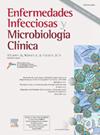PCR检测无症状性传播感染高危患者尿液、直肠和咽样本池中淋病奈瑟菌和沙眼衣原体
IF 2.5
4区 医学
Q3 INFECTIOUS DISEASES
Enfermedades infecciosas y microbiologia clinica
Pub Date : 2025-08-01
DOI:10.1016/j.eimc.2024.11.012
引用次数: 0
摘要
淋病奈瑟菌(NG)和沙眼衣原体(CT)的定期检测是指无症状的患者有危险的性行为。本研究的目的是评估在同一患者的三个样本中采用快速聚合酶链反应(PCR)检测的效果,并将其与分别在三个不同样本中进行的标准PCR进行比较。方法采集有性传播感染(STI)危险的无症状患者。收集每位患者的尿样、2份咽拭子和2份直肠拭子。采用两种PCR技术:分别在三个样品中进行标准PCR (Allplex CT/NG/MG/TV®,Seegene),在三个样品中进行快速PCR (Xpert CT/NG®,Cepheid)。结果403例患者共纳入429份样本,其中尿样426份,直肠拭子412份,咽拭子426份。在CT和NG鉴定中,聚合pcr与个体pcr的一致性为94.17%,阳性样本77份(17.9%)。CT符合率为98.60%,阳性38例(8.88%),NG符合率为95.33%,阳性51例(11.88%)。结论在有感染性病风险的无症状患者中,使用尿液、直肠和咽部三种样本进行NG和CT快速PCR检测是一种经济有效的替代方法,可以分别对三种样本进行常规PCR检测。本文章由计算机程序翻译,如有差异,请以英文原文为准。
Detection of Neisseria gonorrhoeae and Chlamydia trachomatis by PCR in a sample pool (urine, rectum and pharynx) in asymptomatic patients at risk of sexually transmitted infections
Introduction
Detection of Neisseria gonorrhoeae (NG) and Chlamydia trachomatis (CT) is periodically indicated in asymptomatic patients with risky sexual practices. The objective of this study was to assess the efficacy of employing a rapid polymerase chain reaction (PCR) test in a combined pool of three samples from the same patient and compare it with the standard PCR performed in the three different samples separately.
Methods
Samples were collected from asymptomatic patients at risk of sexually transmitted infections (STI). Urine samples, two pharyngeal swabs, and two rectal swabs were collected from each patient. Two PCR techniques were performed: standard PCR (Allplex CT/NG/MG/TV®, Seegene) in each of the three samples separately, and rapid PCR (Xpert CT/NG®, Cepheid) in a pool of three samples.
Results
A total of 429 pooled samples from 403 patients were included in the study, and 426 urine samples, 412 rectal swabs and 426 pharyngeal swabs were also processed. Concordances between pooled and individual PCRs for both CT and NG identification were 94.17%, with 77 (17.9%) positive samples. The concordance for CT was 98.60%, with 38 positive samples (8.88%), being 95.33% for NG, with 51 positive samples (11.88%).
Conclusion
The use of a pool of three samples (urine, rectum and pharynx) for the detection of NG and CT using rapid PCR can be a cost-effective alternative to performing conventional PCR in the three samples separately in asymptomatic patients at risk of developing STI.
求助全文
通过发布文献求助,成功后即可免费获取论文全文。
去求助
来源期刊
CiteScore
2.10
自引率
8.00%
发文量
194
审稿时长
29 days
期刊介绍:
Hoy está universalmente reconocida la renovada y creciente importancia de la patología infecciosa: aparición de nuevos agentes patógenos, de cepas resistentes, de procesos con expresión clínica hasta ahora desconocida, de cuadros de una gran complejidad. Paralelamente, la Microbiología y la Infectología Clínicas han experimentado un gran desarrollo como respuesta al reto planteado por la actual patología infecciosa. Enfermedades Infecciosas y Microbiología Clínica es la Publicación Oficial de la Sociedad Española SEIMC. Cumple con la garantía científica de esta Sociedad, la doble función de difundir trabajos de investigación, tanto clínicos como microbiológicos, referidos a la patología infecciosa, y contribuye a la formación continuada de los interesados en aquella patología mediante artículos orientados a ese fin y elaborados por autores de la mayor calificación invitados por la revista.

 求助内容:
求助内容: 应助结果提醒方式:
应助结果提醒方式:


